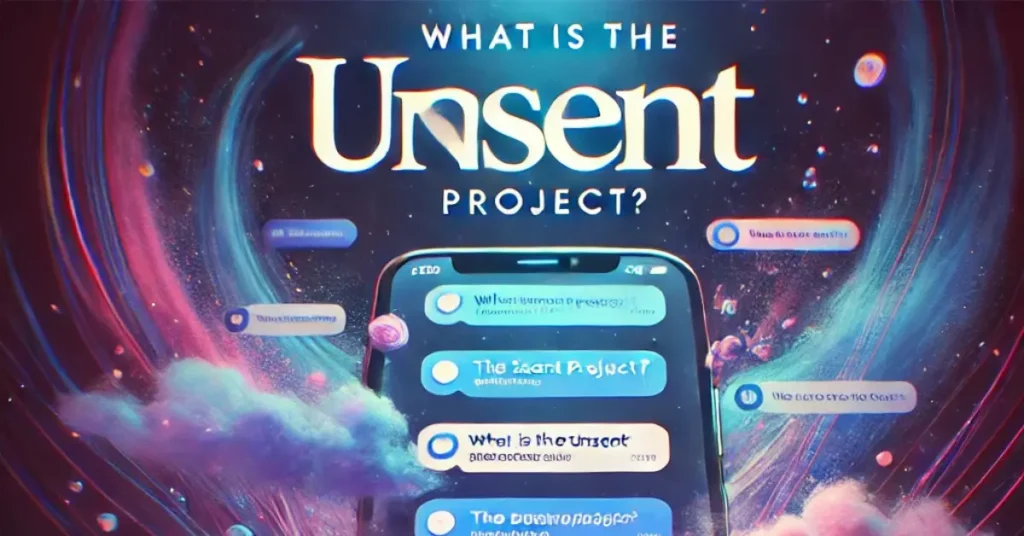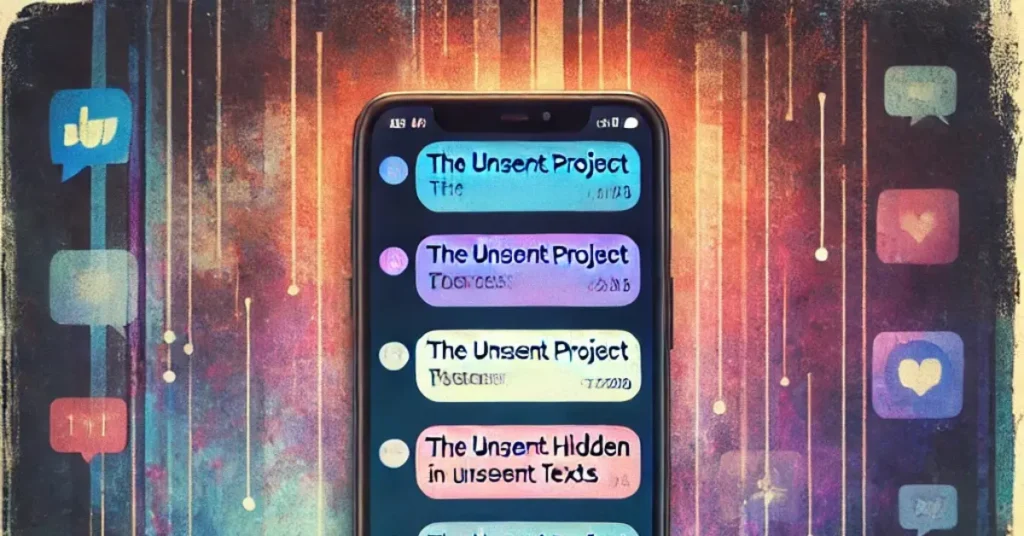The Unsent Project is a unique artistic experiment that captures these raw, unfiltered messages, allowing people to share the words they never had the courage to send.
Created by Rora Blue, this project has gained widespread attention, sparking discussions across social media, particularly on Unsent Project Reddit threads. It has become a digital time capsule of human emotions, revealing the power of words left unspoken.
But what do these messages truly mean? And why do we hesitate to send them? Let’s dive into the hidden depths of The Unsent Project, exploring the psychological reasons behind unsent texts. Their color-coded significance, and how this project has touched millions worldwide.
What Is The Unsent Project?

The Unsent Project is an online collection of unsent text messages, submitted anonymously by people from around the world. It was originally created to explore the relationship between color and emotion. It has since evolved into something much deeper a digital archive of human feelings.
Key Features of The Unsent Project:
- Anonymous Messages: People can submit texts they never sent, addressed to past loves, lost friends, or even themselves.
- Color Association: Each message is paired with a color, representing the sender’s emotions.
- Public Archive: The messages are published online, allowing others to browse and connect with shared experiences.
Since its launch, the project has gathered millions of submissions, revealing universal themes of love, heartbreak, and longing. But this raises an interesting question why do people write unsent messages in the first place?
Why Do We Write But Never Send?
Psychologically, writing an unsent message is a powerful emotional exercise. It allows us to process thoughts, confront our emotions, and release what we’re afraid to express.
Common Reasons for Unsent Messages:
- Fear of Rejection: We hesitate to send messages because we’re afraid of being ignored or hurt.
- Seeking Closure: Writing helps us move on, even if the other person never sees the words.
- Avoiding Conflict: Some thoughts are too painful or complicated to say out loud.
- Nostalgia and Regret: Sometimes, we look back and wonder “what if?”
- Self-Reflection: Writing unsent messages allows us to reflect on our past relationships.
This emotional release explains why The Unsent Project has resonated with so many people. It offers a safe space to share thoughts that might otherwise stay locked away.
The Hidden Meaning of Colors in The Unsent Project
One of the most intriguing aspects of The Unsent Project is its color-coded messages. Each submission is linked to a specific color, symbolizing the sender emotions.
Color Psychology in The Unsent Project
| Color | Emotion or Meaning | Common Themes in Messages |
| Red | Passion, anger, intensity | Heated emotions, deep love, frustration |
| Blue | Sadness, longing, nostalgia | Regret, heartbreak, missing someone |
| Yellow | Happiness, hope, unresolved feelings | Memories of joy, uncertainty |
| Black | Closure, grief, loss | End of a relationship, goodbyes |
| Purple | Mystery, deep connection, mixed emotions | Confusion, spiritual connections |
Many users on Unsent Project Reddit have analyzed messages and color choices, trying to decode deeper meanings. The color selection adds another layer of emotion and storytelling to each message.
Common Themes in The Unsent Project Messages

With millions of messages submitted, certain recurring themes emerge. The messages reveal the universal nature of human emotions, proving that love, loss, and longing are experiences we all share.
Popular Types of Messages Found in The Unsent Project:
- “I still love you, but I know we’ll never be together.” (Regret, heartbreak)
- “Thank you for being the best thing in my life, even if you’re gone.” (Gratitude, nostalgia)
- “I’m sorry I never told you how much you meant to me.” (Missed opportunities)
- “I hope you’re happy wherever you are.” (Letting go, acceptance)
Many users submit messages to ex-lovers, childhood crushes, or even people who have passed away. Each one tells a deeply personal yet universal story, making this project a mirror of collective human emotions.
Impact of The Unsent Project on Mental Health
The Unsent Project offers a therapeutic outlet for individuals to express emotions they couldn’t communicate, helping to alleviate feelings of isolation. It fosters a sense of connection and understanding, promoting emotional healing through shared vulnerability.
How The Unsent Project Helps Emotional Healing
Writing an unsent message can be therapeutic. It allows people to express emotions without judgment, helping them find closure.
Psychological Benefits of Expressing Unsent Thoughts:
Emotional Catharsis: Writing out feelings can reduce emotional stress.
Self-Reflection: Helps people process past relationships and personal growth.
Empathy and Connection: Reading others’ messages makes people feel less alone.
Creative Expression: Provides an outlet for thoughts that might otherwise remain bottled up.
Therapists often recommend writing letters you’ll never send as a way to process emotions. The Unsent Project has taken this concept to a global level, allowing people to find healing through shared experiences.
Controversies and Criticism
Despite its popularity, The Unsent Project has faced some criticism and concerns.
Common Concerns:
- Privacy Issues: Should deeply personal messages be shared publicly?
- Emotional Triggers: Reading painful messages may intensify feelings of sadness.
- Over-Reliance on the Past: Does this project encourage people to dwell on memories instead of moving forward?
Some users have also reported technical issues, asking “Why is my Unsent Project not sending?” or “When will the Unsent Project be back?” due to occasional website downtime.
How to Submit to The Unsent Project
Want to share your own unsent message?
Here’s how you can participate:
Steps to Submit Your Message:
- Visit theunsentproject.com.
- Click on “Submit” and type your unsent message.
- Choose a color that represents your emotions.
- Submit it anonymously.
If you’re looking for The Unsent Project alternative, you can also write letters to yourself, use a personal journal, or explore similar anonymous message-sharing platforms.
Final Thought
The Unsent Project is more than just an art experiment it is a powerful emotional archive that captures what it means to be human. By allowing people to express the words they never sent. It has created a digital space for healing, nostalgia, and connection.
Frequently Asked Questions
Is the Unsent Project real?
Yes, The Unsent Project is a real artistic initiative by Rora Blue, showcasing millions of anonymous unsent messages.
How to view unsent messages?
You can browse messages on The Unsent Project website by searching names or filtering by color.
What are the colors on the Unsent Project?
Colors represent emotions tied to each message, with red often symbolizing love and blue sadness.
Does the Unsent Project delete messages?
No, submitted messages remain on the website unless removed by the creator or project administrators.
Can people see your unsent?
Yes, once submitted, messages are publicly displayed without revealing the sender’s identity.
Who runs the Unsent Project?
The Unsent Project is created and managed by artist Rora Blue as part of her digital art explorations.
Do unsent messages get seen?
Yes, messages appear on the website, allowing visitors to explore anonymous submissions.
What apps can see unsent messages?
No official app can retrieve deleted messages, but some third-party tools claim to recover them.
What happens when you unsent a message?
If you “unsend” a message in a chat app, it typically disappears, but recipients may have already seen it.






